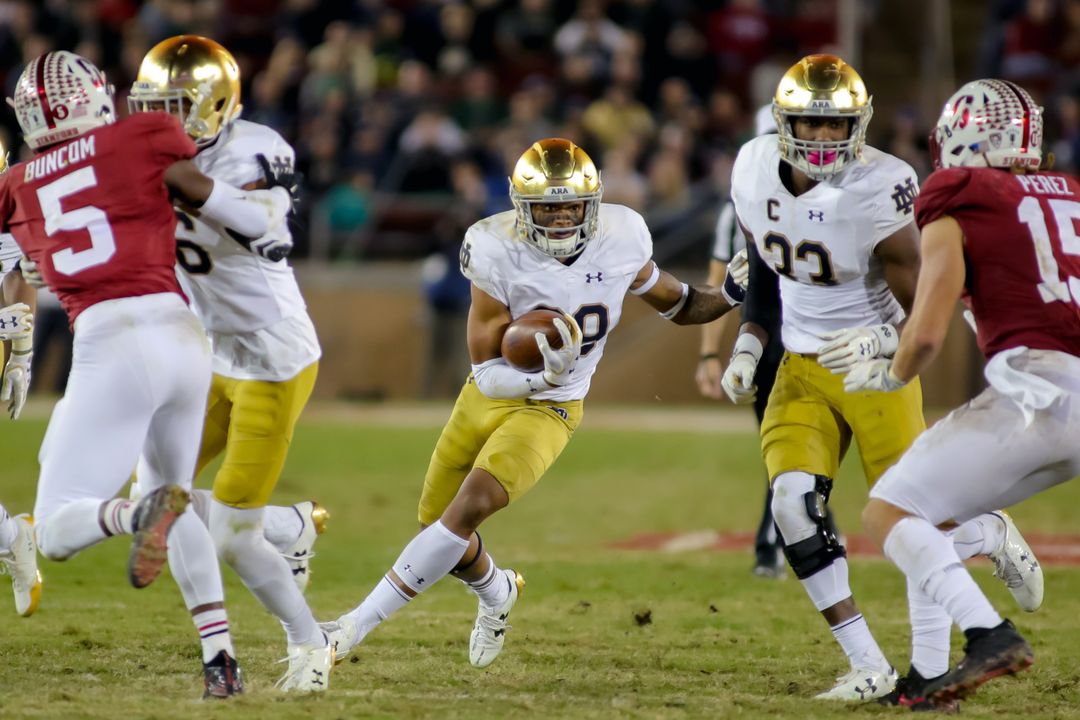Nov. 27, 2017
By John Heisler
Ten wins for the second time in three seasons — and the third time in six years. A final record with six more wins than a year ago, matching the second-best turnaround in school history in terms of victories (only the 1964 team going 9-1 after a 2-7 mark in ’63 would have done better).
The eighth-rated Irish had hoped to make those items come to fruition Saturday by defeating 21st-rated Stanford — but the Cardinal came from behind with three final-period scores to emerge victorious 38-20.
That means those earlier goals will remain intact for some sort of postseason bowl game, with specifics to be determined this weekend.
Here’s what came out of Saturday night in Palo Alto:
- The Irish both lived and died via the turnover in 2017. In Notre Dame’s nine victories this season the Irish finished a combined plus-11 in the turnover department, including plus-three at Michigan State and versus USC and plus-two against Miami (Ohio). Over a six-game stretch (all victories) the Irish in five of those did not turn the football over. However, in their three losses this fall the Irish were a combined minus-seven in the turnover column — including minus-four at Miami (Florida) and minus-three at Stanford. It may qualify as an oversimplification, but the Irish were almost impossible to beat when they did not turn the ball over — but they only once won a game (Temple) when losing in the turnover column. Meanwhile Stanford played five games in 2017 without a turnover — and one of those happened to be Saturday night against the Irish. As Irish coach Brian Kelly said after the contest, “We turned a good game into a not-so-good game by turning it over.”
- The Notre Dame running game was something to celebrate. Despite somewhat of a November slowdown, Notre Dame over the course of 2017 ran the football as well as it had in more than two decades. The Irish ended the regular season ranked seventh as a team in running the football for its top ranking to date (bowl games also count in final NCAA stats) since a number-six finish in 1995. Notre Dame’s current 279.1-yard per-game average is the best by a Notre Dame team since 1992 (280.9). The highlight of that spree came in a midseason stretch when Notre Dame in consecutive games against Miami (Ohio), North Carolina, USC, North Carolina State and Wake Forest ran for at least 318 yards and averaged 349.8 per game over that stretch. Notre Dame’s 35.3-point scoring average is the best by an Irish team in a dozen seasons — and the total offense mark of 454.9 yards per outing has been surpassed only one time in the last 11 years.
- A quick turnaround. On an evening that featured a pair of passing plays that combined exceeded any other two in that category in Notre Dame history, the Irish took a 20-17 lead into the final period in what had been a back-and-forth contest. Then Stanford put three touchdowns on the board in a little more than three and a half minutes — and that essentially decided the outcome. It all came on a pleasant California evening in which Stanford coach David Shaw said his team “might have played our best game of the year.”
- Defensive takeaways hard to come by late. The Irish made a living in many games this year by taking the ball away from their opponents at a far greater rate than a year ago, just for example. But that proved harder to do down the stretch. Mike Elko’s troops forced 18 combined turnovers in September and October games, then only two in November. The Irish ended the regular season rated 31st nationally in turnover margin at plus-0.42 per game. Miami (Florida) leads the nation in that category (plus-1.55), boosting that average with a 4-0 advantage in the ‘Canes win over the Irish.
- Unsung Irish heroes. Notre Dame’s defense featured a couple of players who made notable national statistical impacts during the regular season. Senior captain and rover Drue Tranquill ended up with three fumble recoveries and no other player in the country has more than four (Tranquill ranks fourth nationally). Corner Julian Love ended up with 1.7 passes broken up per game–a figure surpassed only by Iowa’s Joshua Jackson (2.1).







